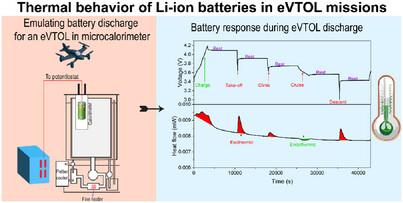Thermal Dynamics and Lithium Plating Detection in High-Power Li-Ion Batteries for eVTOL Applications
IF 26
1区 材料科学
Q1 CHEMISTRY, PHYSICAL
引用次数: 0
Abstract
The rapid electrification of aerial transportation is driving the need for high-performance Li-ion batteries that can operate reliably under stringent thermal and safety constraints. The unique mission profile of electric Vertical Take-off and Landing (eVTOL) aircraft necessitates a focused investigation into the thermal behavior and safety characteristics of these batteries. In this study, operando isothermal microcalorimetry is employed to examine the thermal evolution of Li-ion batteries under cycling conditions representative of eVTOL operations. These findings reveal that high-power discharge events—such as those during take-off and landing—shift the thermal response toward exothermic behavior, in contrast to the typically endothermic response expected under near-equilibrium cycling conditions. Additionally, the results suggest that advanced electrolyte formulations may help suppress excess heat generation, thereby improving battery safety. Notably, the calorimetric results exhibit a distinct thermal signature associated with lithium plating, offering a potential diagnostic for detecting Li plating during eVTOL operation. Overall, this study demonstrates the utility of isothermal microcalorimetry as a valuable tool for assessing thermal risks in Li-ion batteries for eVTOL applications, and highlights the importance of targeted design strategies to mitigate safety hazards during high-power demand scenarios.

eVTOL大功率锂离子电池的热动力学和镀锂检测
航空运输的快速电气化推动了对高性能锂离子电池的需求,这种电池可以在严格的热和安全限制下可靠地运行。电动垂直起降(eVTOL)飞机的独特任务要求对这些电池的热行为和安全特性进行重点研究。在本研究中,使用操作等温微量热法来研究锂离子电池在eVTOL操作的循环条件下的热演化。这些发现表明,高功率放电事件(例如在起飞和降落期间)将热响应转向放热行为,而不是在接近平衡循环条件下预期的典型吸热响应。此外,研究结果表明,先进的电解质配方可能有助于抑制多余的热量产生,从而提高电池的安全性。值得注意的是,量热结果显示出与镀锂相关的明显热特征,这为eVTOL操作过程中检测镀锂提供了潜在的诊断方法。总体而言,该研究证明了等温微热法作为评估eVTOL应用中锂离子电池热风险的有价值工具的实用性,并强调了在高功率需求场景下,有针对性的设计策略对于减轻安全隐患的重要性。
本文章由计算机程序翻译,如有差异,请以英文原文为准。
求助全文
约1分钟内获得全文
求助全文
来源期刊

Advanced Energy Materials
CHEMISTRY, PHYSICAL-ENERGY & FUELS
CiteScore
41.90
自引率
4.00%
发文量
889
审稿时长
1.4 months
期刊介绍:
Established in 2011, Advanced Energy Materials is an international, interdisciplinary, English-language journal that focuses on materials used in energy harvesting, conversion, and storage. It is regarded as a top-quality journal alongside Advanced Materials, Advanced Functional Materials, and Small.
With a 2022 Impact Factor of 27.8, Advanced Energy Materials is considered a prime source for the best energy-related research. The journal covers a wide range of topics in energy-related research, including organic and inorganic photovoltaics, batteries and supercapacitors, fuel cells, hydrogen generation and storage, thermoelectrics, water splitting and photocatalysis, solar fuels and thermosolar power, magnetocalorics, and piezoelectronics.
The readership of Advanced Energy Materials includes materials scientists, chemists, physicists, and engineers in both academia and industry. The journal is indexed in various databases and collections, such as Advanced Technologies & Aerospace Database, FIZ Karlsruhe, INSPEC (IET), Science Citation Index Expanded, Technology Collection, and Web of Science, among others.
 求助内容:
求助内容: 应助结果提醒方式:
应助结果提醒方式:


